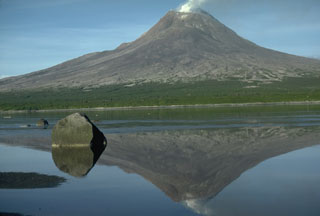Global Volcanism Program | Image GVP-05279

A pyroclastic flow travels down the north flank of Augustine volcano in Alaska on 30 March 1986, three days after the start of a five-month long eruption. An ash plume rises above the pyroclastic flow. As with many Augustine eruptions, early pyroclastic flows were pumice rich; later in the eruption block-and-ash flows were produced by collapse of a growing lava dome.
Photo by Betsy Yount, 1986 (Alaska Volcano Observatory, U.S. Geological Survey).
![]() This image is made available as a Public Domain Work, but proper attribution is appreciated.
This image is made available as a Public Domain Work, but proper attribution is appreciated.
Galleries: Pyroclastic Flows
Keywords: pyroclastic flow | pyroclastic density current (PDC) | block-and-ash flow | co-ignimbrite plume | ash | eruption | explosive eruption

Augustine
